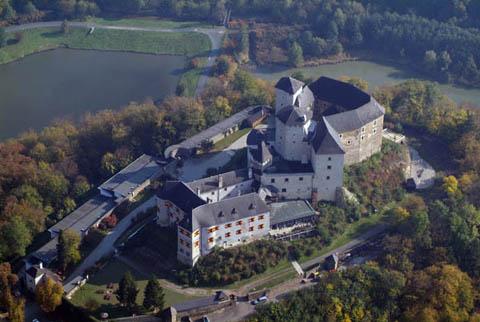The castle is located in the Güns Valley, set amidst a hilly terrain in eastern Austria, near the Hungarian border towards Kőszeg. It is located in the southeastern part of the town of Lockenhaus, roughly 120 kilometres south of Vienna and roughly the same distance by road northeast of Graz. It was built on the spur of a hill, which is now called the Castle Hill. It can be reached by express bus service along the Eisenstadter Bundestrasse. A lake lies immediately to the east of the castle.
Settlements in the area of Burg Lockenhaus date to the Stone Age. Illyrians and Celts who settled here are credited with building the castle around 1200 with construction material available locally, although it first appears in written records dated to 1242. Burgenland's oldest fortress, Burg Lockenhaus was built to defend the area against the Mongols. The Romans annexed the area and included it as a part of the Pannonia province under the Roman Empire. German and Slavic people inhabited the castle. Notable owners included: Duke Frederick the Warlike, Henry II of Güssing, the Bohemian king, Ottakar II and King Maximilian II. The castle was destroyed in 1337 under Charles I of Hungary.
The town was given a market status in 1492. Finally the castle went to the Nadasdy family. Francis II Nadasdy married Elizabeth Báthory, a descendant of Stephan Báthory, who went down in history as the Blood Countess, because of her reign of terror, torturing, and murdering hundreds of women for sadistic pleasure.
The castle and the town saw substantial improvements during the reign of Francis III Nadasdy (1622–1671) who was Lord Lieutenant, Royal Council, Chief Chamberlain and Chief Justice, since 1664. He married Julia Anna Esterhazy, daughter of Palatine Nikolaus Esterházy. In 1676, Count Paul Esterhazy, brother of Nadasdy took possession of the castle. During the Turkish War in 1683, there was substantial damage to the town and the castle. In the uprising during the 18th century, there was further looting and destruction.
During the First World War and the period that followed there was no change in the status of the castle, till 1921. The castle underwent reconstruction only after the Second World War under the Red Army. In 1968, Professor Paul Anton Keller and his wife Margaret, bought the Lockenhaus Castle, which at that time was in ruins. They sold all their possessions for the purpose of refurbishing it. The refurbishing was estimated to cost €800,000., of which they spent their own money of €500,000. Before restoration completion, Professor Keller died. However, his wife continued the work, completed the task and renamed the castle as "Prof. Paul Anton Keller Foundation – Castle Lockenhaus" in honour of her husband. A Board of Trustees, established in July 1980, has managed the further restoration works undertaken with more funds collected from the public. Eugene Horvath, a retired General and a financial consultant, has contributed substantially to the trust’s activities. Burg Lockenhaus is part of the Naturpark Geschriebenstein. The castle is the setting for the medieval scenes in Rudolf Steiner's mystery drama, The Soul's Probation.









0 comments:
Kommentar veröffentlichen